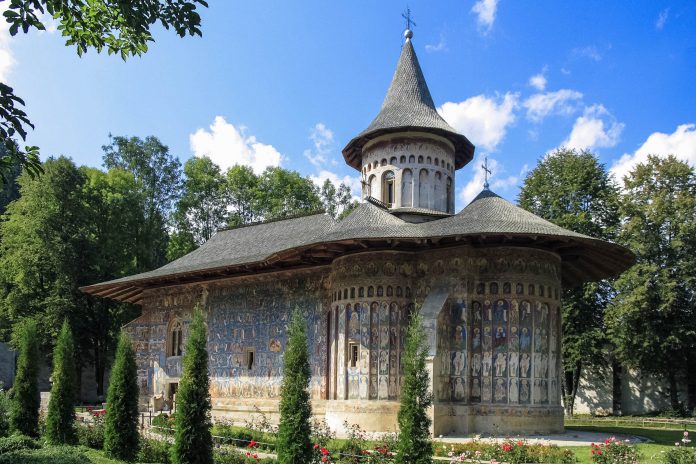Die Moldauklöster in der südlichen Bukowina bestechen durch ihre einzigartigen farbenfrohen Fresken, die sowohl die Innen- und Außenwände als auch die Schutzmauern über und über bedecken.
Die Moldauklöster liegen in der südlichen Bukowina in Rumänien, dem einstigen Kronland der österreichischen Monarchie. Einige der farbenprächtigen Gotteshäuser zählen seit 1993 bzw. 2010 zum Weltkulturerbe der UNESCO und gehören zu unseren Top 10 Sehenswürdigkeiten von Rumänien, sowie zu unseren 10 sehenswertesten Klöstern der Welt.
Inhaltsverzeichnis
Entstehung der Moldauklöster
Als die rumänisch-orthodoxen Moldauklöster im 15. und 16. Jahrhundert errichtet wurden, hieß das Gebiet noch Fürstentum Moldau, daher ihre Bezeichnung. Erster Auftraggeber für die Moldauklöster war Ștefan cel Mare (Stefan der Große), der als Herrscher und Symbolfigur Moldawiens in die Geschichte einging.
Angeblich ließ er nach jedem erfolgreichen Feldzug eine Kirche oder ein Kloster errichten. So kam es zu nicht weniger als 40 Sakralbauten, die an seine Siege über die Ungarn, Polen und Türken erinnern sollen. Seine Nachfolger, allen voran Petru Rares, setzten den traditionellen Bau von Moldauklöstern fort.
Einzigartigkeit der Moldauklöster
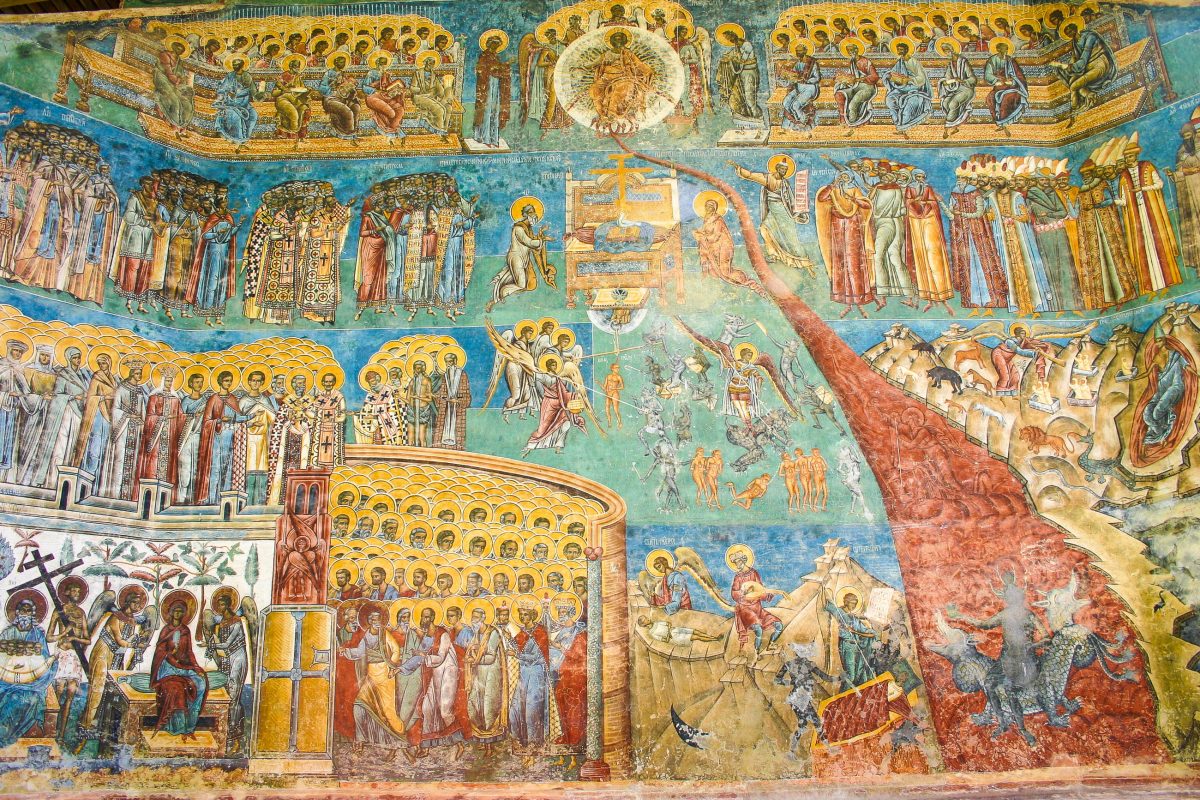
Kloster gibt es überall – warum sollte man gerade die Moldauklöster besichtigen? Das Besondere an den Moldauklöstern ist ihre in Europa einzigartige farbenprächtige Bemalung.
Die Mönche wollten auch dem niederen Volk, das weder Schreiben noch Lesen konnte, die Inhalte der Heiligen Schrift näher bringen. Und so verwendeten sie Innenwände, Fassaden und Schutzmauern des Klosters um in farbigen Zeichnungen, Malereien und Fresken Szenen und Gleichnisse aus der Bibel darzustellen.
Durch die Verzierung der Außenwände wurden auch Menschen auf die Geschichten aus dem Christentum aufmerksam, die aus welchen Gründen auch immer, die Kirchen nicht betreten wollten oder durften. Die Fresken wurden von teilweise unbekannten Künstlern geschaffen und gelten als absolute Meisterwerke der byzantinischen Kunst.
Wo findet man die Moldauklöster?
Das erste Moldaukloster, das von Ștefan cel Mare errichtet wurde, war das Kloster Putna in der gleichnamigen Stadt. Es entstand in den Jahren 1466 bis 1469 und liegt malerisch in einem Tal der östlichen Karpaten.
Die größte Stadt in der Region der Moldauklöster ist Suceava, die neben dem Auto auch mit der Bahn oder dem Flugzeug erreichbar ist. Alle sehenswerten Moldauklöster befinden sich in einem Umkreis von 60km.
Von Suceava geht es weiter nach Gura Humorului (nahe der Klöster Humor und Voronet) und nach Vatra Moldovitei (nahe des Klosters Moldovita). Die südlich von Suceava gelegenen Klöster können über Falticeni, Pascani und Bacau erreicht werden. Unterkünfte sind in so gut wie allen Orten zu finden.
Welche sind die schönsten Moldauklöster?
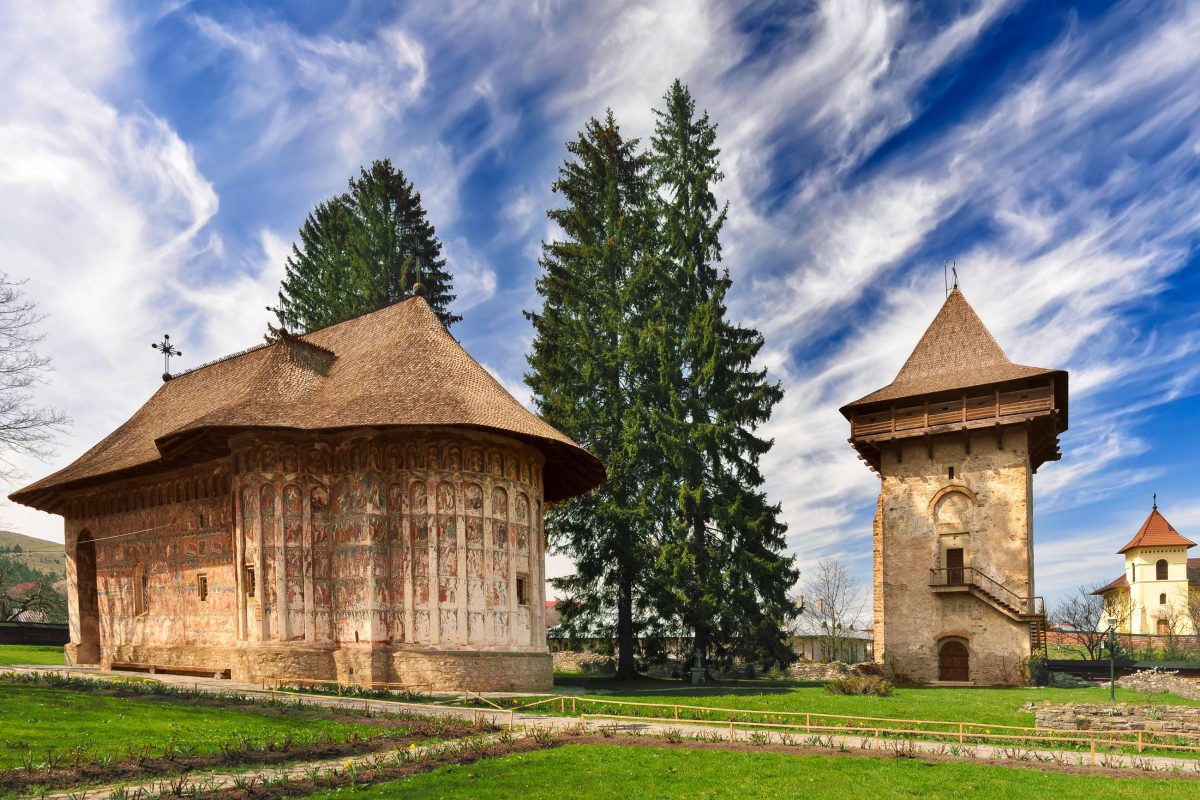
Einige der Malereien wurden im Lauf der Zeit durch die Witterung zerstört, doch ein Großteil der Darstellungen ist bis heute erhalten. Die verwendeten Farben, die sich bis heute hielten, geben den Experten bis heute Rätsel auf. Man weiß mittlerweile, dass sie aus Pflanzen- und Mineralienpigmenten hergestellt und auf der nassen Mauer verwendet wurden, konnte das Rezept jedoch nicht vollständig nachvollziehen.
Die schönsten Malereien sind auf den Mauern der Klöster Arbore, Moldovița, Sucevița und Voroneț zu finden. Diese sind auch alle Teil des UNESCO-Weltkulturerbes. Dazu gehören außerdem noch die Klöster Humor, Pătrăuți, Probota und Suceava.
Kloster Putna
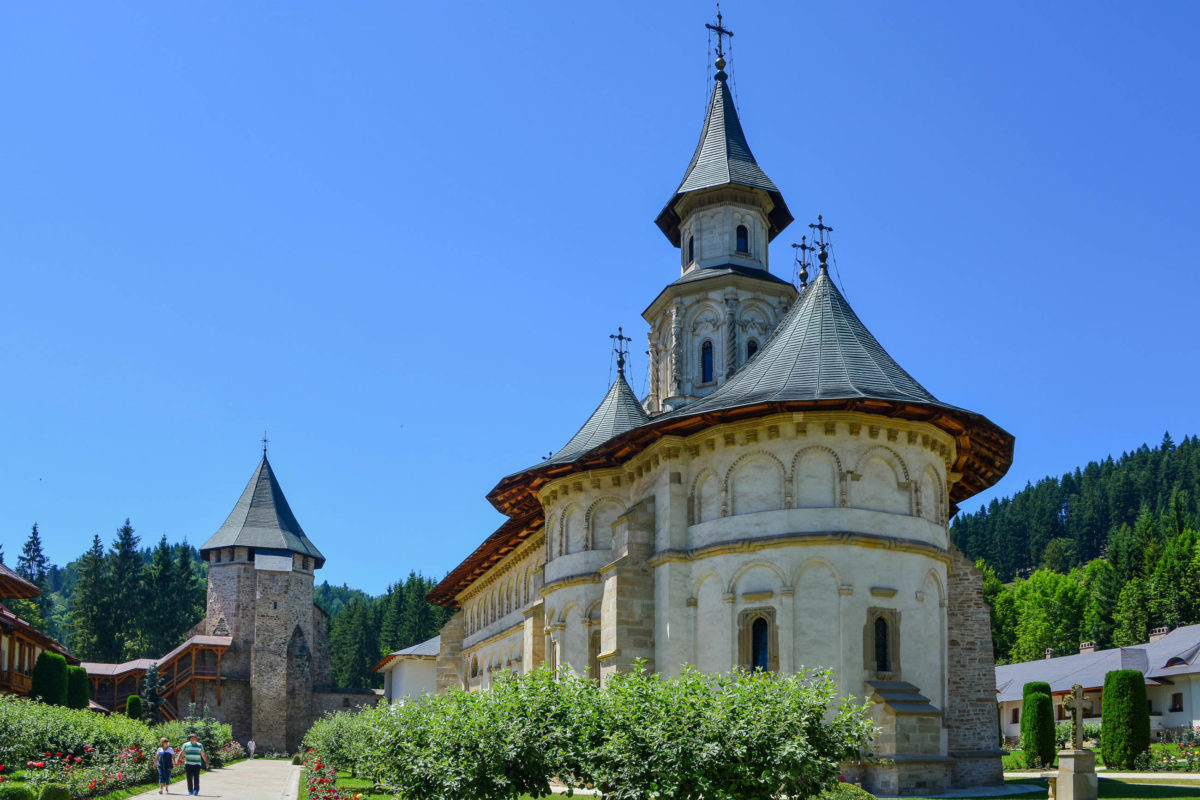
Als ihr erstes hat das Kloster von Putna unter den Moldauklöstern einen ganz besonderen Stellenwert. Bei der Besichtigung der Moldauklöster solltet ihr es auf keinen Fall versäumen.
Zur Zeit seiner Entstehung war das Kloster, ebenso wie die übrigen Moldauklöster, innen und außen über und über mit meisterhaften Fresken geschmückt. Die Klosterkirche wurde 1653 von den Tartaren zerstört und bis 1662 wieder errichtet – die spektakulären Wandmalereien wurden jedoch nicht wieder erneuert.
Deshalb ist das Kloster von Putna im Gegensatz zu den meisten anderen Moldauklöstern von außen nicht so fantastisch anzusehen. Aufgrund seiner tieferen Bedeutung für die Klöster der Bukowina ist es jedoch allemal einen Besuch wert!
Bilder: Kloster Putna
Entstehung des Klosters Putna
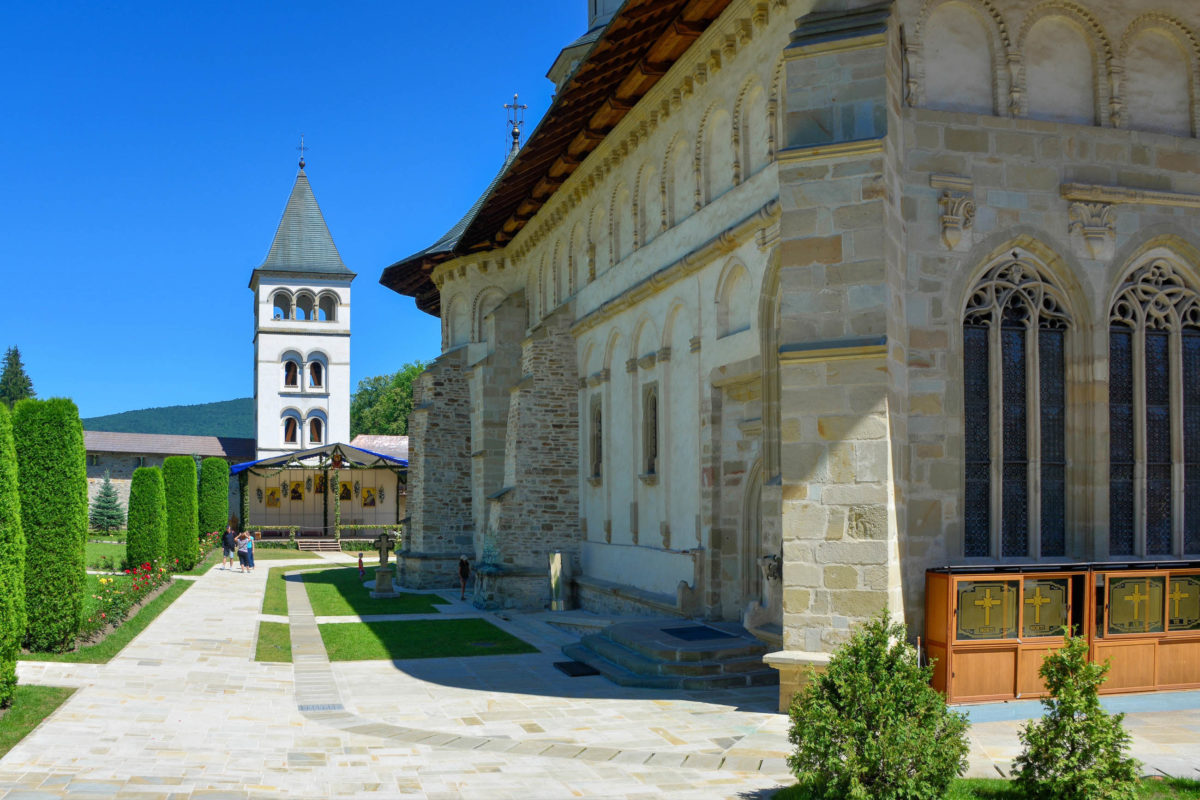
Das rumänisch-orthodoxe Kloster in Putna wurde zwischen 1466 und 1469 von Fürst Ștefan cel Mare in einem malerischen Tal der östlichen Karpaten errichtet. Der Sage nach schoss er einen Pfeil ab und wo dieser landetet, steht heute der Altar des Klosters. Am 3. September 1470 wurde das Kloster geweiht.
In den darauffolgenden Jahrhunderten entwickelte sich Putna zu einem geistlichen Zentrum, in dem Mönche ausgebildet, religiöse Texte übersetzt, wertvolle Manuskripte bewahrt und Chroniken verfasst wurden. Die florierende Waldwirtschaft auf dem größten Landbesitz der Bukowina machte Putna ebenfalls weithin bekannt.
Auch als letzte Ruhestätte von Fürst Stefan dem Großen kommt dem Kloster von Putna besondere Bedeutung zu. Er wurde 1504 in Putna bestattet, wo auch seine zweite und dritte Frau begraben liegen. Ihre Grabsteine sind auf dem Klosterfriedhof bis heute zu sehen. 1992 wurde Stefan cel Mare als „Schirm und Schutz des christlichen Glaubens“ von der Orthodoxen Kirche heilig gesprochen und seither am 2. Juli gefeiert.
Besuch des Klosters von Putna
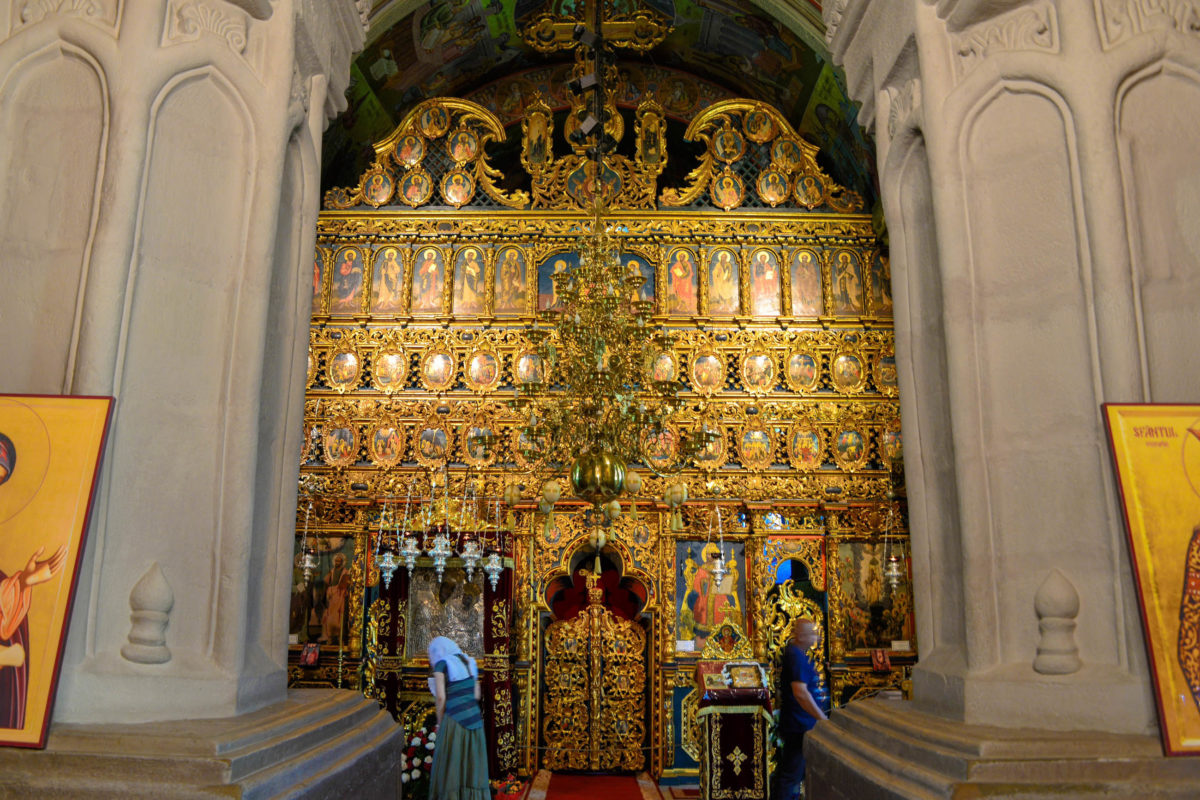
Durch ein Tor im Schatzturm aus dem Jahr 1481 wird das von einer dicken Mauer umschlossene Kloster von Putna betreten. Kloster, Klosterkirche und Klostergarten bilden hinter dem Torbogen ein malerisches Ensemble. Eine Büste im Klostergarten von Putna erinnert an Mihai Eminescu, Rumäniens bedeutendsten Dichter im 19. Jahrhundert.
Im Inneren der Klosterkirche sind nun auch die Fresken zu sehen, für die die Moldauklöster so berühmt sind. Auch hier waren die Malermeister Mihail und Gavill Morosan am Werk. Unter einem Baldachin aus weißem Marmor fällt sofort die Grabstätte von Fürst Stefan ins Auge.
Klostermuseum von Putna
Ebenfalls interessant ist das Klostermuseum, welches mit wertvollen Manuskripten und historischen Landkarten an die damalige Bedeutung des Klosters erinnert und als das wichtigste Klostermuseum Rumäniens gilt. Weiters befinden sich Gold- und Silberarbeiten, Gemälde, Ikonen, Leinentücher und sakrale Gegenstände unter den Exponaten, die bis ins 15. Jahrhundert zurückdatiert wurden.
Zu den größten Schätzen zählen die kunstvoll verzierten Grabtücher von Stefan dem Großen und seiner zweiten Frau Maria de Mangop aus dem Jahr 1477, sowie die mit Goldfäden aufwändig bestickte Ikonostasen-Vorhänge aus dem Jahr 1484. Sie gehören zu den bedeutendsten der Welt und sind von unschätzbarem kulturhistorischem Wert.
Kloster Humor
Die heutige Klosterkirche von Humor wurde im Jahr 1530 unter Petru Rares errichtet und dem Fest Mariä Himmelfahrt geweiht. Nicht weit entfernt sind noch die Ruinen der 1415 erbauten Vorgängerkirche zu sehen. Die Verantwortung über den Bau übernahmen damals der Großkanzler Toader Bubuiog und seine Frau Anastasia, die beide in der Kirche begraben liegen.
BILDER: Kloster Humor
Entstehung der Fresken am Kloster Humor
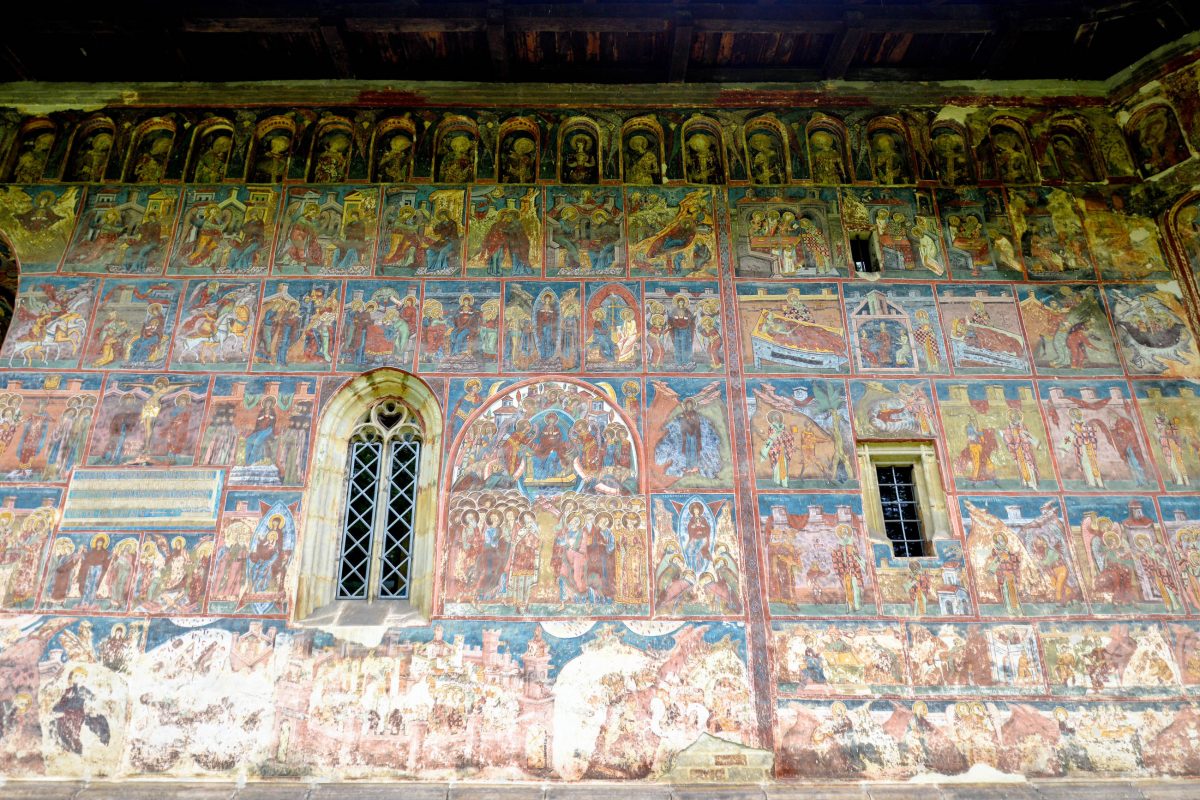
Fünf Jahre nach Fertigstellung des Klosters, also 1535, kamen die fantastischen Wandmalereien vom Künstler Toma Zugravul von Suceava hinzu, um auch den Analphabeten der Region die Lehren der Bibel näher zu bringen. Zwei Jahre danach schmückte dieser auch das Kloster Moldovița. Damit sind die Fresken am Kloster Humor die ältesten aller Moldauklöster und trotzdem noch erstaunlich gut erhalten.
1785 wurde aus dem Kloster eine Dorfschule, 1850 wurde es zu einem Warenlager umfunktioniert und erst ab 1991 wird es wieder als Kloster genutzt – bis heute von rumänisch-orthodoxen Nonnen. Durch das Fehlen des Turms und die teils verblichenen Fassadenmalereien wirkt das Humor-Kloster etwas unscheinbarer als andere Klöster der Bukowina.
Der viereckige Glockenturm, der sich neben dem Kloster befindet, wurde im Jahr 1641 unter der Herrschaft des moldawischen Fürsten Vasile Lupu erbaut.
Fresken und Merkmale des Humor-Klosters

Das Humor-Kloster unterscheidet sich von anderen Moldauklöstern durch seinen auffälligen offenen Vorbau mit den beiden großen Rundbögen, die es sonst nur noch beim nahegelegenen Moldovița-Kloster gibt.
An dieser Westfassade ist das Jüngste Gericht mit dem Feuerstrom, der sich von den Füßen Jesu in die Hölle ergießt, das vorherrschende Motiv. Da die Fresken hinter den Bögen besser vor Wind und Wetter geschützt waren, sind sie hier auch besser erhalten, als an den ungeschützten Außenmauern.
Die kunstvollen Wandmalereien an der wettergeschützten Südseite des Humor-Klosters sind bis heute am besten erhalten geblieben und auch der Grund für die Ernennung zum Weltkulturerbe.
Insgesamt 24 Szenen stellen die 24 Strophen des Hymnus Akathistos dar und auch die am Moldovița-Kloster so berühmte Darstellung der Belagerung Konstantinopels aus dem Jahr 626 ist zu sehen, bei der die Perser aus Propaganda-Gründen damals als Türken dargestellt wurden. Die vorherrschende Farbe Rotbraun ist hier besonders gut zu erkennen.
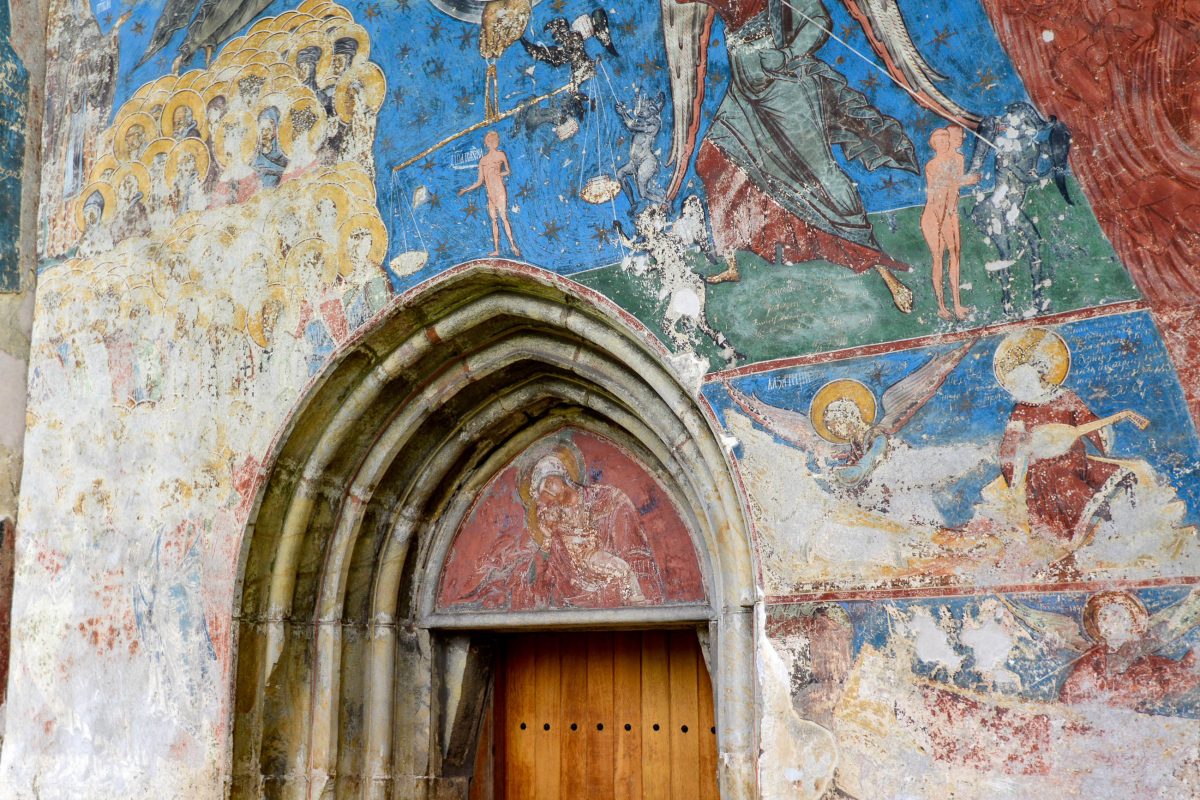
Fresken im Inneren des Humor-Klosters
Im Inneren der Kirche beeindrucken im Vorraum Darstellungen des Kirchenkalenders mit Abbildungen von Heiligen und Märtyrern in den Qualen ihrer letzten Stunden. Im Hauptraum dominieren die Himmelfahrt der Jungfrau Maria und die Passion Christi.
Auch ein Abbild von Petru Rares ist zu sehen, der eine Miniaturversion der Kirche an Jesus Christus übergibt. Die Kuppel und die Grabkammer sind der Heiligen Maria gewidmet, die von Heerscharen von Engeln und Königinnen umgeben ist.
Über der Grabkammer des Großkanzlers und seiner Gattin verbirgt sich ein geheimer Raum, in dem früher in Krisenzeiten Wertsachen aufbewahrt werden konnten – eine weitere Einzigartigkeit von Humor unter den Moldauklöstern.
Kloster Sucevița
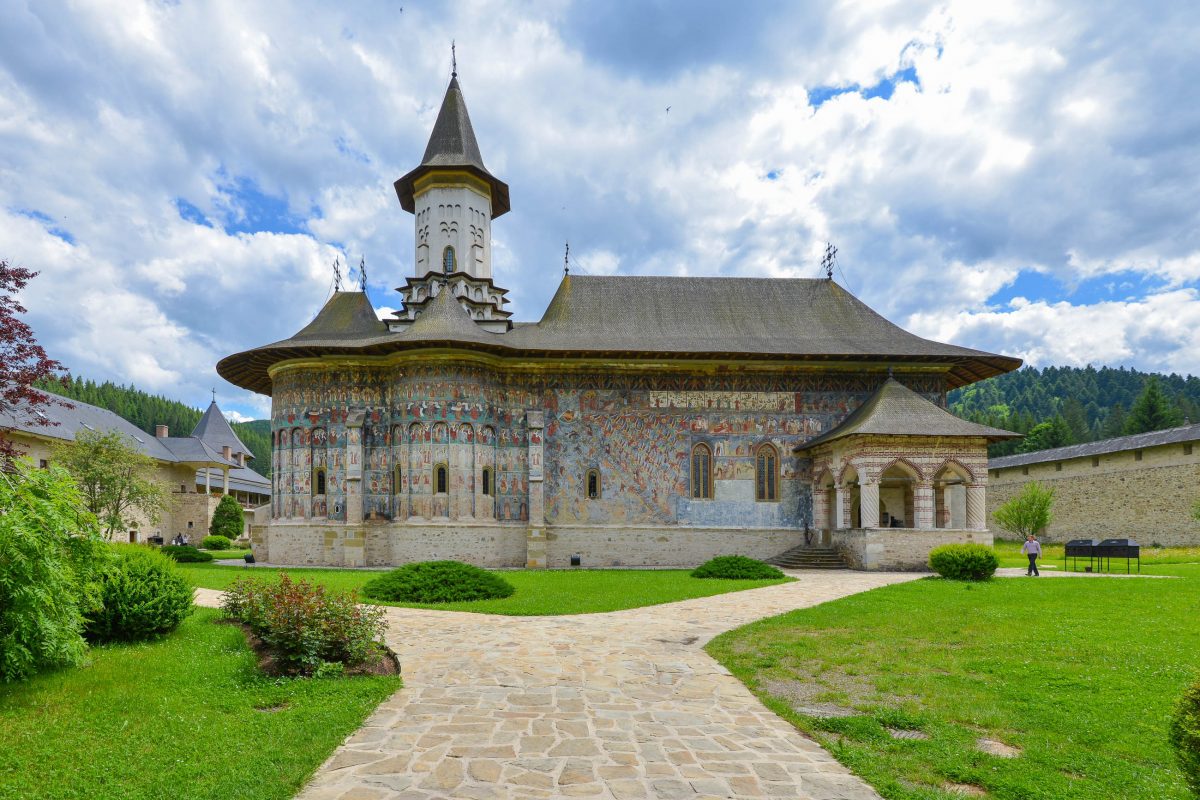
Die am besten erhaltenen Außenfresken
Der Grund, aus dem die Wandmalereien des Klosters Sucevița so gut erhalten sind, liegt in seiner vergleichsweise späten Errichtung. Während das erste Moldaukloster in Putna bereits 1466 errichtet wurde, entstand das Kloster von Sucevița erst knapp 120 Jahre Jahre später.
Damals, von 1582 bis 1584 gebaut, wurde es vom Moldau-Fürsten Ieremia Movilă gestiftet. Die Gebeine Ieremias und seines Bruders Simion ruhen heute in der Kirche unter kunstvoll behauenen Grabplatten aus Marmor und einem eindrucksvollen Deckenfresko, welches Moses Auszug aus Ägypten zeigt.
Ein Jahr nach Fertigstellung des Baus kamen die imposanten Wehrmauern und die vier Ecktürme rund um die Kirche hinzu. Im ehemaligen Ratssaal des heutigen Nonnenklosters ist heute ein kleines Museum untergebracht, das neben Handschriften, Büchern und Ikonen auch kostbare mit Gold und Juwelen bestickte Grabtücher der Herrscherfamilie Movilă zeigt.
BILDER: Kloster von Sucevița
Fotogalerie: Kloster von Sucevița
Überwältigende Fresken am Kloster von Sucevița
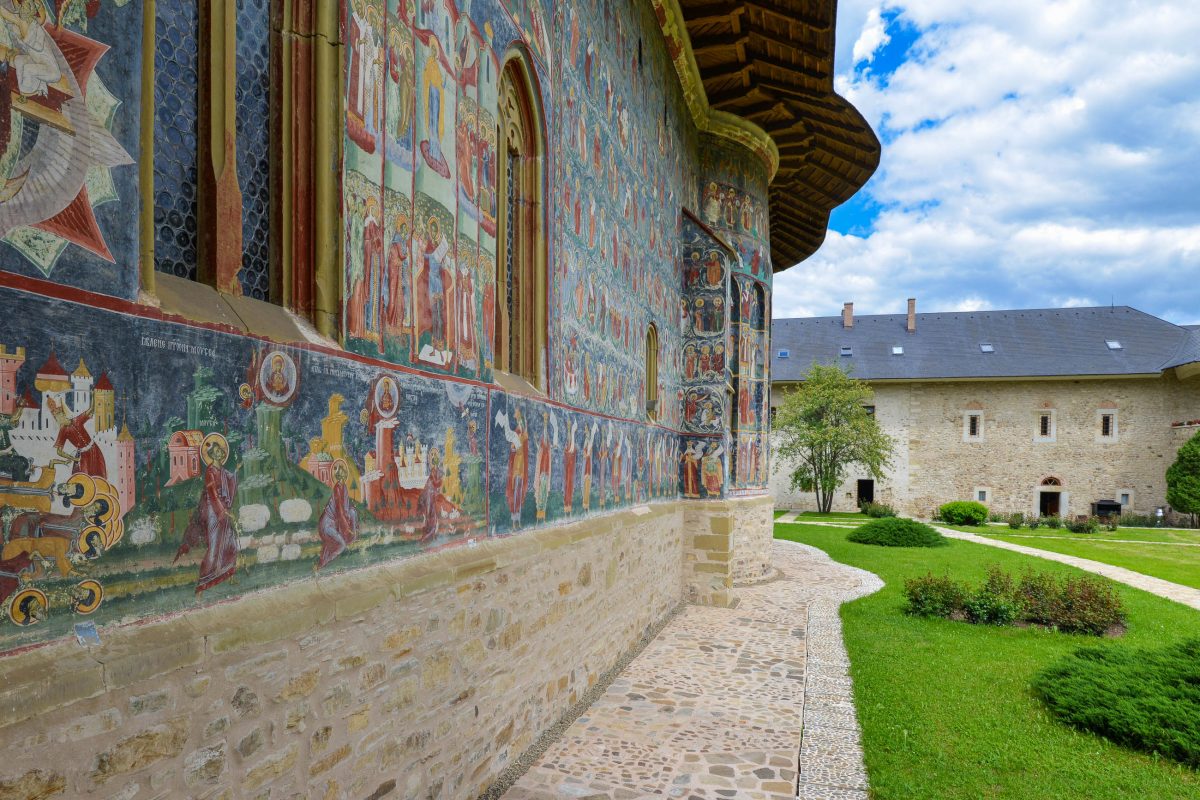
Ein Jahr nach Fertigstellung der Klostermauern wurden sowohl die Außen-, als auch die Innenmauern mit der prachtvollen Bemalung geschmückt, die bis heute sowohl Touristen als auch Experten in Staunen versetzt. Als Künstler der Fresken am Kloster von Sucevița werden die Brüder Ion und Sofronie Zugravul genannt.
Die Farben, mit denen sie vor über 400 Jahren gearbeitet haben, und die bis heute noch sichtbar sind, konnten bis heute nicht vollständig nachvollzogen werden. Gemeinsam mit dem Grün des Gartens und dem Blau des Himmels ergibt der farbenfrohe Bilderteppich auf der Kirchenfassade ein überwältigendes Fotomotiv.
„Stufenleiter der Tugenden“

Besonders eindrucksvoll anzusehen ist die „Stufenleiter der Tugenden“ an der Nordseite der Kirche. Sie zeigt mit farbenprächtigen Details den Gegensatz zwischen himmlischer Ordnung – Engel, die in Reih und Glied schweben – und höllischem Chaos – Menschen, die von gehörnten Kreaturen verfolgt und in den Abgrund gezogen werden. Dazwischen führt die Leiter der Lebenden zum Himmelstor. Experten betrachten diese Darstellung als eine der schönsten aller Moldauklöster.
Weitere Fresken und Innenräume
Neben der Tugendleiter zeigt die Fassade noch das Jüngste Gericht am Vorbau, aber auch bekannte Größen der griechischen Antike, wie Platon, Aristoteles und Pythagoras. Lediglich die Westseite blieb unbemalt.
Im Inneren ist der Hauptraum dem Leben Christi gewidmet und zeigt im Westen und Süden die Herrscherfamilie Movilă, im Vorraum sind die Kirchenfeste im Jahreskreis dargestellt. Einen Blick wert ist auch die barocke Altarwand, deren Schnitzereien um 1800 fertiggestellt wurden.
Kloster Moldovita
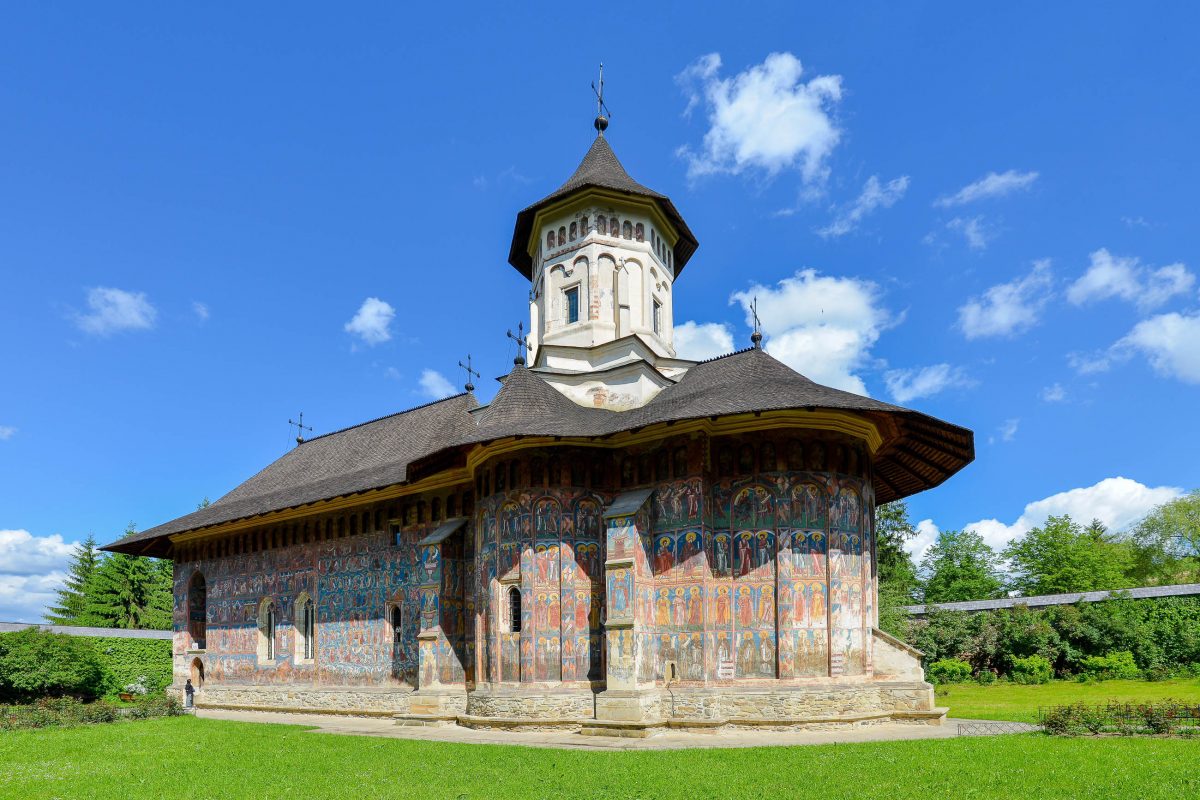
Die der Mariä Verkündigung geweiht Klosterkirche des Klosters Moldovița wurde 1993 von der UNESCO zum Weltkulturerbe erklärt. Die imposante Klosterkirche thront inmitten eines herrlichen Gartens und ist von 5m hohen und gut 1m dicken Mauern mit kreisrunden steinernen Wehrtürmen umgeben.
Die detailliertesten Wandmalereien
Inmitten dieser idyllischen Kulisse ragen die herrlich bemalten Mauern des Moldovița-Klosters empor, das von einer heimischen Nonne einst treffend als „Heilige Schrift in Farbe“ bezeichnet wurde.
In einem Nebengebäude des Klosters befindet sich heute ein Museum, das unter anderem von Stefan dem Großen persönlich gestiftete Stickereien aus dem 16. Jahrhundert und ein Evangeliar aus dem Jahr 1613 beherbegt. Gegründet wurde das kleine Museum vom Bischof Efrem, der im Kloster begraben liegt.
BILDER: Kloster von Moldovița
Fotogalerie: Kloster Moldovița
Geschichte des Klosters Moldovița
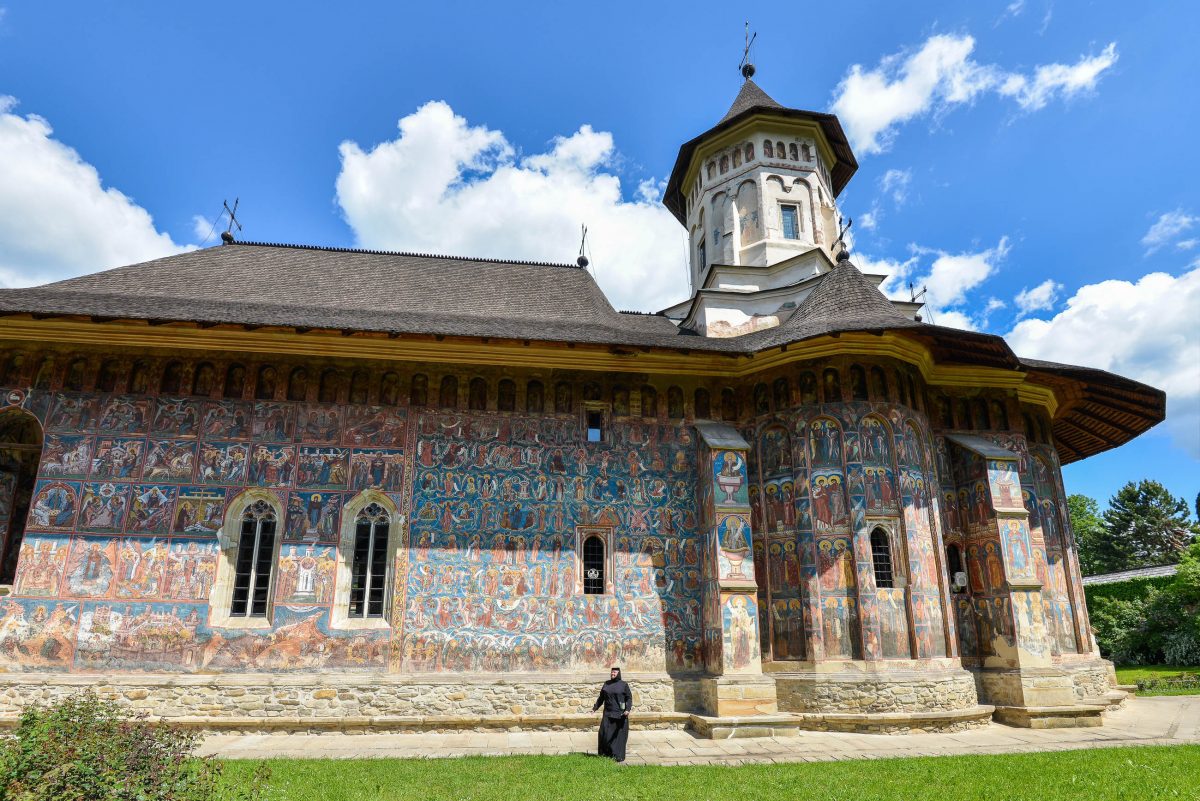
Der Vorgängerbau des heutigen Klosters wurde bereits im Jahr 1410 zum ersten Mal erwähnt, fiel jedoch einem Erdrutsch zum Opfer. Im Jahr 1532 ließ Petru Rareş, Sohn von Stefan dem Großen, dem Initiator der berühmten Moldauklöster, ein neues Kloster bauen. Ebenso wie am Kloster Humor war der Schöpfer der prachtvollen Fresken an der Klosterfassade Toma Zugravul aus dem nahe gelegenen Suceava.
Fünf Jahre nach Bau des Klosters waren die farbigen Kunstwerke in Rot, Blau und Gelb abgeschlossen. Heute sind sie leider nicht mehr so gut erhalten, wie die Malereien der Klöster Voroneț oder Sucevița, sind jedoch aufgrund ihres unglaublichen Detailgrades einen Besuch wert. 1785 wurde das Kloster aufgelöst und 1935 als rumänisch-orthodoxes Frauenkloster wieder eröffnet.
Fresken am Kloster Moldovița
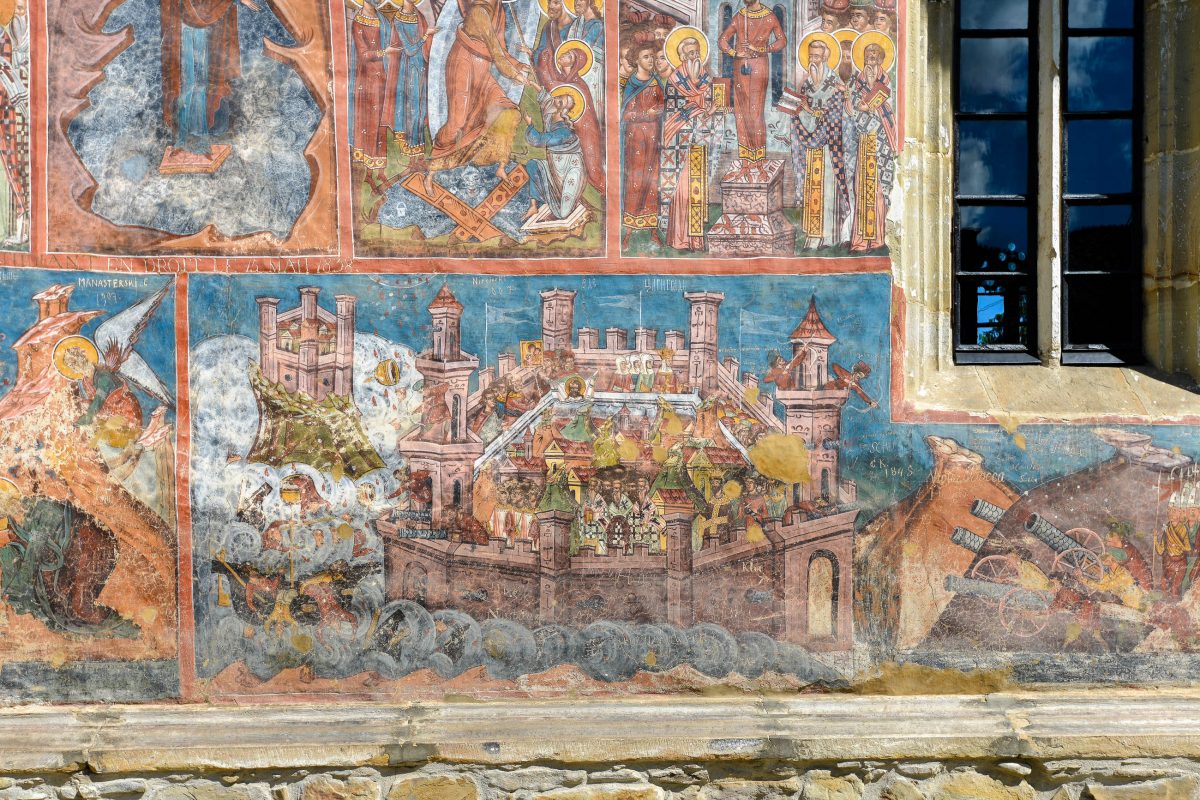
Das bekannteste Fresko am Kloster Moldovița ist die fantastische Darstellung der Belagerung Konstantinopels an der Südfassade.
Im Gegensatz zu anderen berühmten Fresken, wie zum Beispiel dem Jüngsten Gericht, das die gesamte West-Fassade des Voroneț-Klosters einnimmt, ist das „Aushänge-Fresko“ von Moldovița fast klein geraten. Es zeigt in unglaublichem Detailgrad eine Szene aus dem Jahr 626, als die Festung des historischen Istanbul einer Belagerung durch die Perser standhalten musste und der Legende nach durch ein Wunder der Jungfrau Maria gerettet wurde (die Feinde im Bild sind allerdings eindeutig als Türken dargestellt).
Das Motiv ist zwar auch auf anderen Moldauklöstern zu finden, doch diese Darstellung ist eindeutig die schönste und am besten erhaltene.
Ebenfalls an der Südwand, rechts von der Belagerung Konstantinopels stellt der berühmte und oft gemalte Stammbaum Jesse die Vorfahren Christi vor, während Propheten, Heilige, Mönche und Apostel die Rundungen der Apsis zieren.
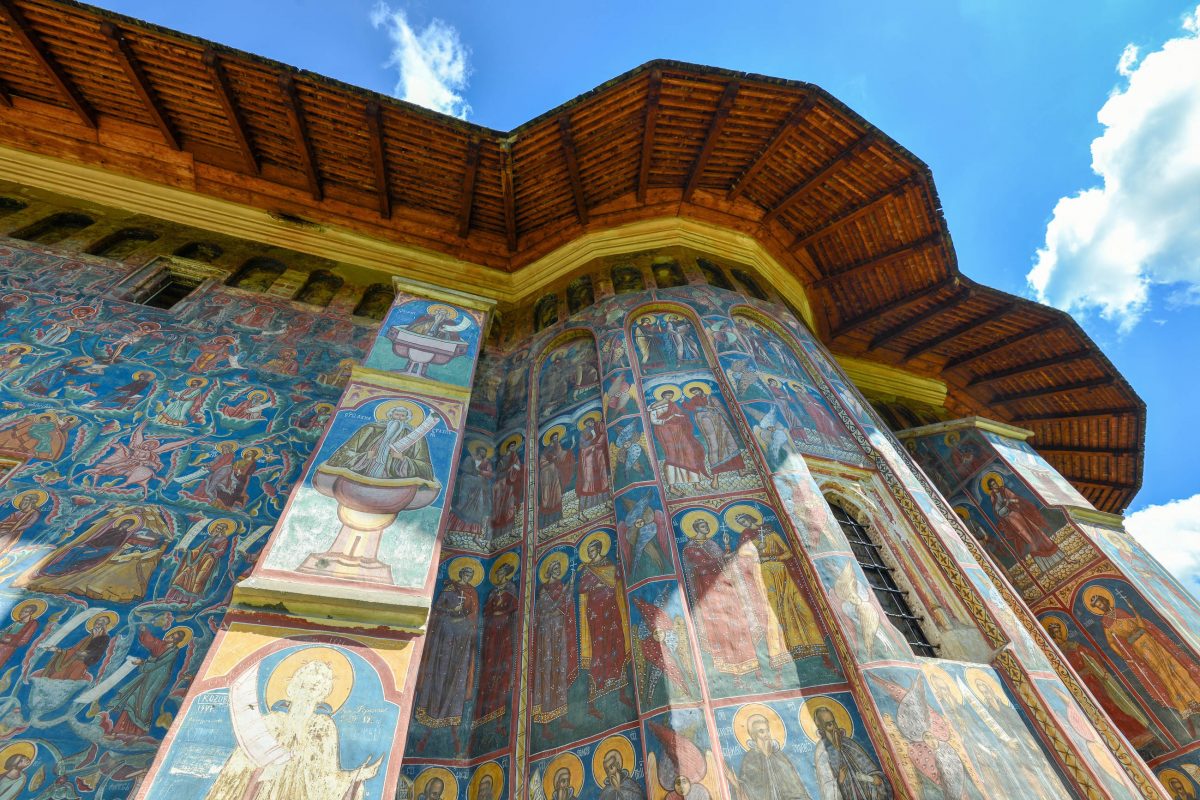
Auffällig ist auch die Vorhalle des Klosters, mit ihren drei großen Rundbögen an der Ostseite, die in dieser Art sonst nur noch beim Kloster Humor zu sehen ist. Sowohl die Außenmauer als auch das Innere des Vorbaus schmücken Szenen aus dem Jüngsten Gericht, mit dem glutroten Fluss aus Feuer und dem Meer der Verdammten. Die prächtigen Malereien an der Ostfassade des Klosters sind durch die Verwitterung jedoch kaum noch zu erkennen.

Das Innere der Kirche zeigt alle 12 Monate des Kirchenjahres und zahlreiche Märtyrer in eindrucksvollen Bildern. Im Altarraum beeindruckt die vergoldete Wand und die Darstellung der Passion Christi, die zu den kostbarsten Kunstwerken aller Moldauklöster der Bukowina zählt. Hier ist auch Kloster-Stifter Petru Rareş mit seiner Familie als Abbild verewigt.
Kloster Voroneț
Das Kloster Voroneț im gleichnamigen Dorf im Norden Rumäniens beherbergt innerhalb seiner Klostermauern die Kirche des Heiligen Georg. Die „Sixtinische Kapelle des Ostens“ wurde 1993 von der UNESCO zum Weltkulturerbe erklärt.
Das Kloster von Voroneț wurde von Mai bis September 1488 in der Rekordzeit von drei Monaten und 21 Tagen unter der Herrschaft von Stefan dem Großen errichtet. Seinen aufwändigen Fassadenschmuck erhielt es jedoch erst 1534-1535 unter dem Fürsten Petru Rares, Sohn von Stefan dem Großen.
Anreise zum Voroneț-Kloster

Die Ortschaft Voroneț liegt im Norden von Rumänien 5km von der Stadt Gura Humorului entfernt (wo sich das Moldaukloster Humor befindet) und ist für sein berühmtes Kloster weithin bekannt. Nicht nur, weil die Kirche als einzige der historischen Klosterbauten noch erhalten ist, sondern vor allem wegen seiner farbenprächtigen Außenmauern.
Fresken der „Sixtinischen Kapelle des Ostens“

Besonders berühmt ist die Darstellung des Jüngsten Gerichts, die die gesamte fensterlose West-Fassade des Voroneț-Klosters einnimmt. Von oben bis unten reichen fünf Bilderreihen von Gott mit seinen Engeln über Jesus Christus und den Heiligen Geist als weiße Taube mit Adam und Eva bis zur Waage, die die Menschen in Gut und Böse teilt und die Hölle mit dem Teufel, in die sich der markante leuchtend rote Feuerstrom ergießt.
Auf der Südseite rechts neben dem Eingang ist unter dem Fenster die so genannte Fürbitten-Gruppe mit Jesus Christus, der Mutter Maria und Johannes dem Täufer zu sehen.
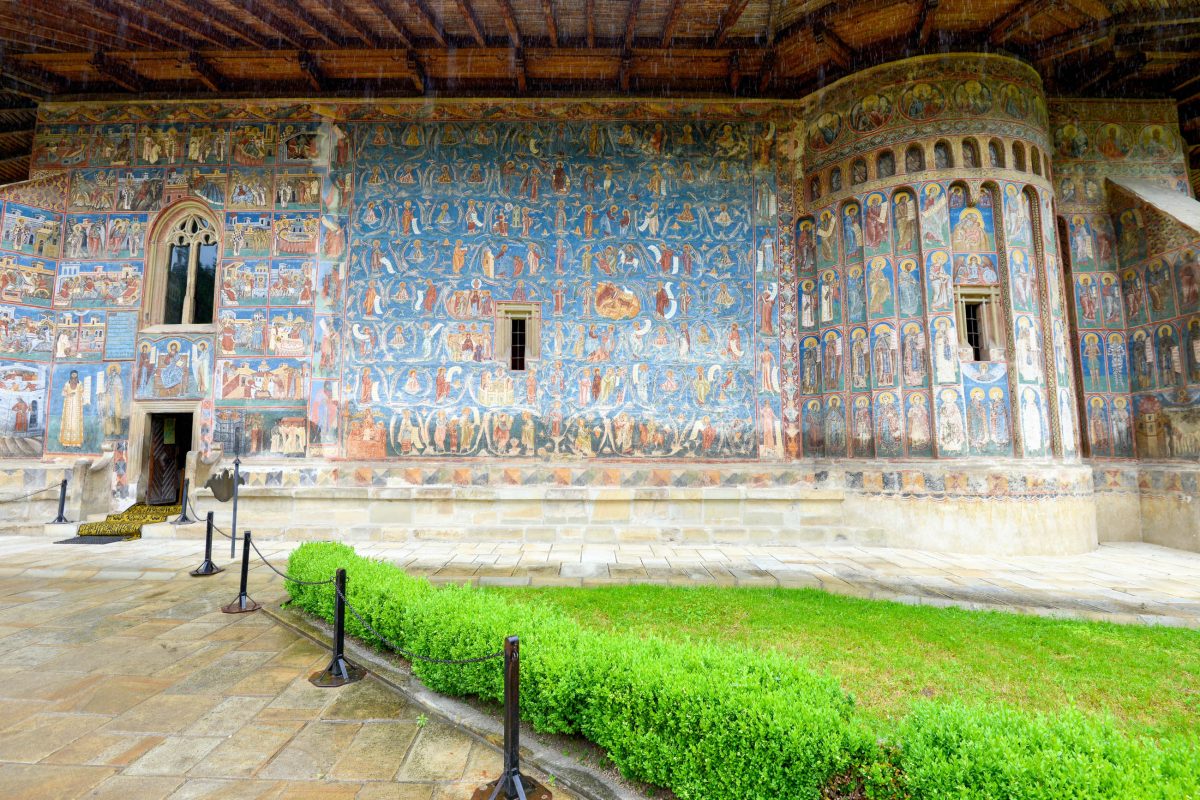
Rechts daneben beeindruckt der besonders detailreiche „Stammbaum Jesses“. Hier ist das berühmte „Blau von Voroneț“ besonders gut zu sehen, welches einst aus gemahlenem Azurit hergestellt wurde (und nicht aus Lapislazuli, wie manchmal zu lesen ist). Heute ist es bis über die Landesgrenzen bekannt.
Weiter im Osten sind Apostel, Heilige und Märtyrer mit der Heiligen Maria und dem Jesuskind abgebildet. Auch die Apsis ist mit Heiligenbildern regelrecht übersät. Unter den Figuren aus der Bibel finden sich auch Philosophen der Antike, wie zum Beispiel Platon, Sokrates oder Aristoteles. Auffällig sind auch die beiden großen Figuren gleich links neben der Eingangstür.
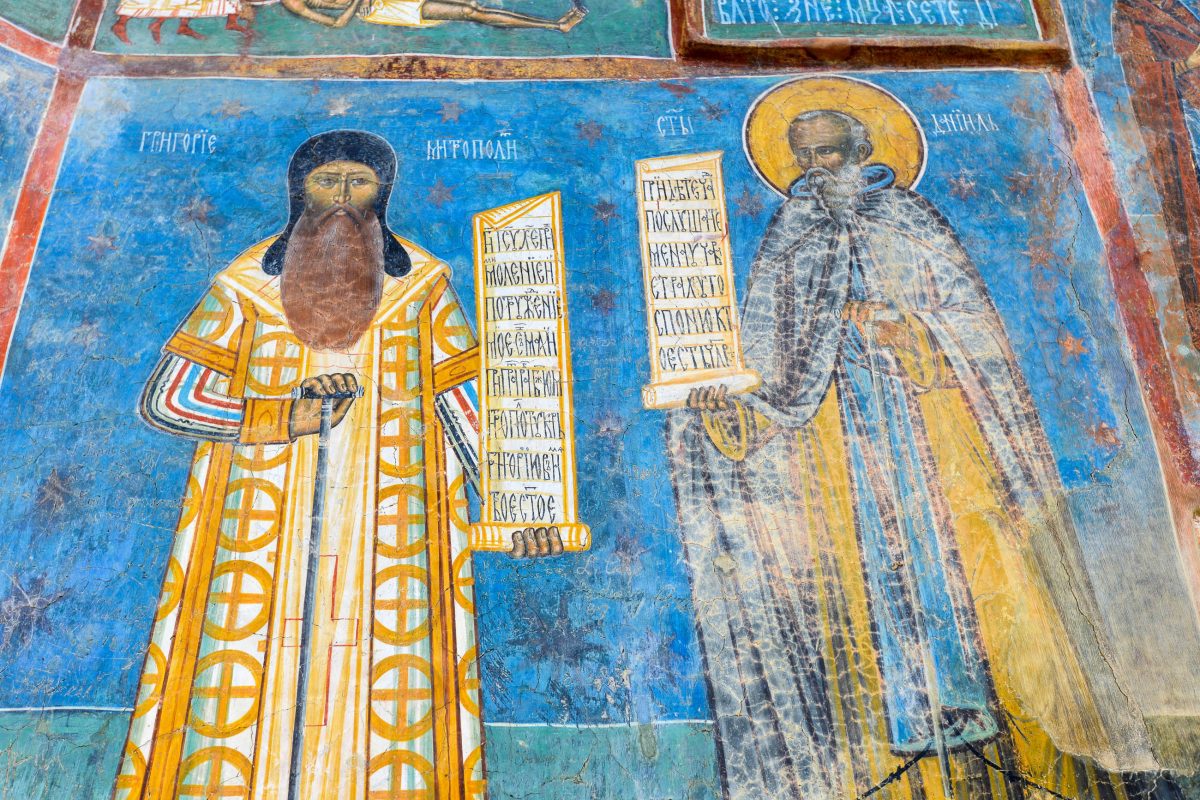
Sie zeigen den Bischof Grigore Roscas, der damals die Aufsicht über die Entstehung der Malereien über hatte, und den Einsiedler Daniil Sihastru mit Heiligenschein, der der Legende nach Stefan dem Großen seinen Sieg gegen die Türken vorausgesagt hatte, aufgrund dessen die Moldauklöster errichtet worden waren. Beide Männer liegen bis heute im Kloster begraben.
An der Nordseite, die durch die Witterung am stärksten von allen verblichen ist, sind Adam und Eva im Paradies auszumachen. Um ausreichend Platz für die herrlichen Malereien zu lassen, sind die gotischen Fenster sehr klein ausgefallen und lassen auch nur wenig Tageslicht in den Innenraum der Kirche, was eine ganz besondere, mystische Stimmung erzeugt.
Fresken im Inneren des Klosters Voroneț
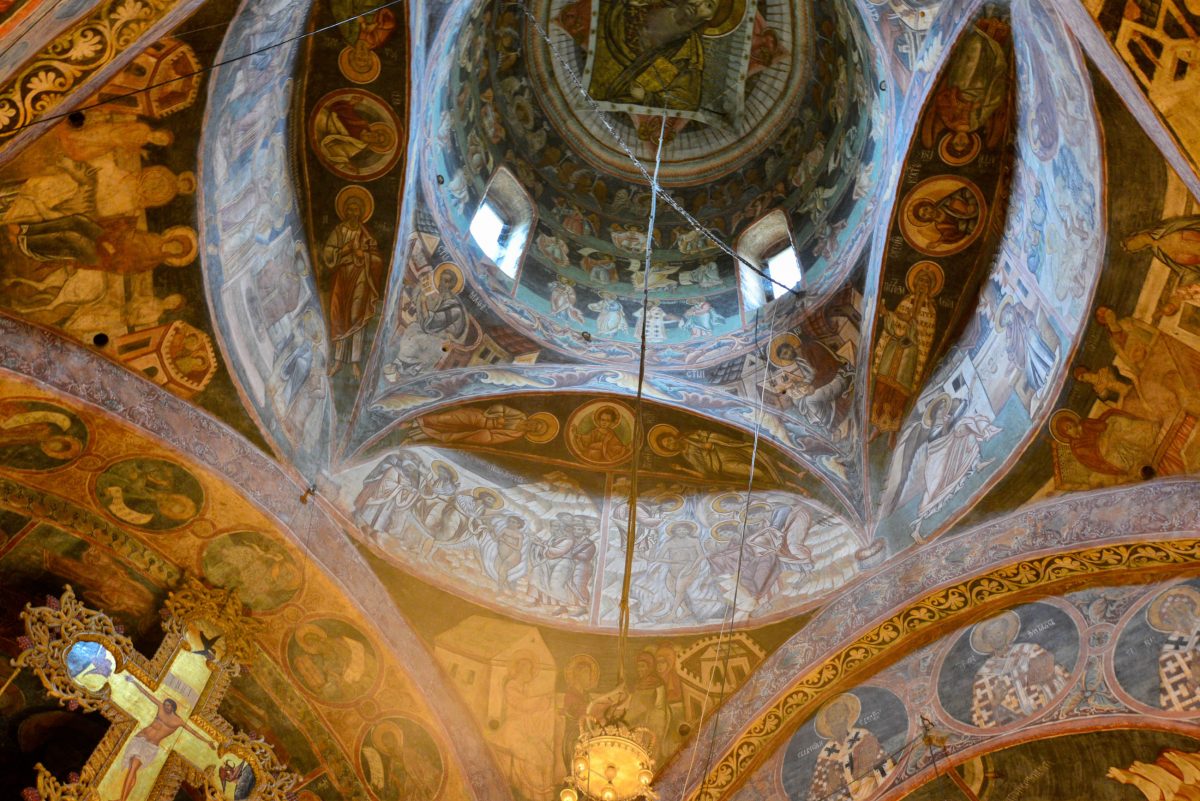
Die herrlichen Fresken am Kloster Voronet setzen sich auch im Inneren der Kirche fort und sind (aufgrund einer teils bis heute ungeklärten Farbrezeptur) bis heute erstaunlich gut erhalten. Innerhalb des Turms befindet sich die berühmte moldauische Kuppel, deren Bemalung ebenfalls noch gut sichtbar ist.
Das Kloster war bis 1786 von Mönchen bewohnt, wurde jedoch von der damals österreichischen Regierung der Bukowina aufgelassen. Erst 1989 zog wieder Leben ins berühmte Voroneț-Kloster ein.
Kloster Arbore
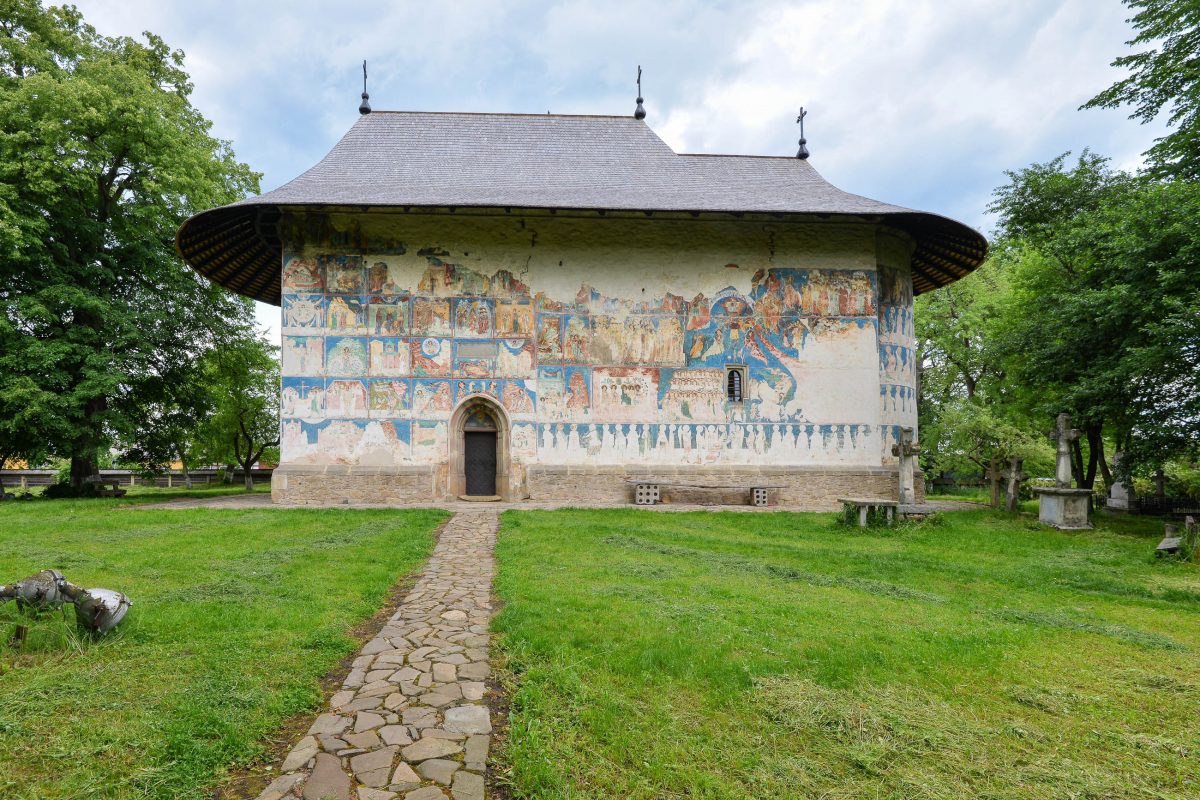
Auf den ersten Blick wirkt das Kloster Arbore weniger spektakulär als die übrigen Moldauklöster in Rumänien. Es ist klein, zierlich und nicht einmal mit einem Turm versehen. Dennoch ist es seit 1993 Weltkulturerbe der UNESCO und wird in vielen Reisemagazinen zu den schönsten bemalten Klöstern des Landes gezählt. Vor allem der bemalte Innenraum versetzt jeden Betrachter in sprachloses Staunen.
BILDER: Kloster Arbore
Besuch der Klosterkirche von Arbore
Das Kloster von Arbore liegt im Nordwesten von Rumänien, etwa eine halbe Autostunde westlich der Kreishauptstadt Suceava. Etwas abgelegener als andere Touristenattraktionen ist Arbore selten überlaufen. Neben der sehenswerten Kirche beherbergt das Kloster auch ein ethnographisches Museum.
Die Kirche Tăierea Capului Sfântului Ioan Botezătorul („Enthauptung des Heiligen Johannes des Täufers“) wurde von April bis August 1502 von Luca Arbore, einem General, Ratgeber und guten Freund von Stefan dem Großen, dem „Vater der Moldauklöster“, errichtet.
Dies ist auch der Grund für den fehlenden Turm der Klosterkirche. Ihr Erbauer war kein Fürst, sondern nur ein einfacher Adeliger, der übrigens gemeinsam mit seiner Ehefrau Iuliana in der Kirche begraben liegt. Glocken gibt es an der Klosterkirche dennoch, allerdings in einem eigenen Turm, der etwas abseits des Kirchleins als Eingang zum Klosterhof errichtet wurde.
Farbenprächtige Darstellungen im Kloster Arbore
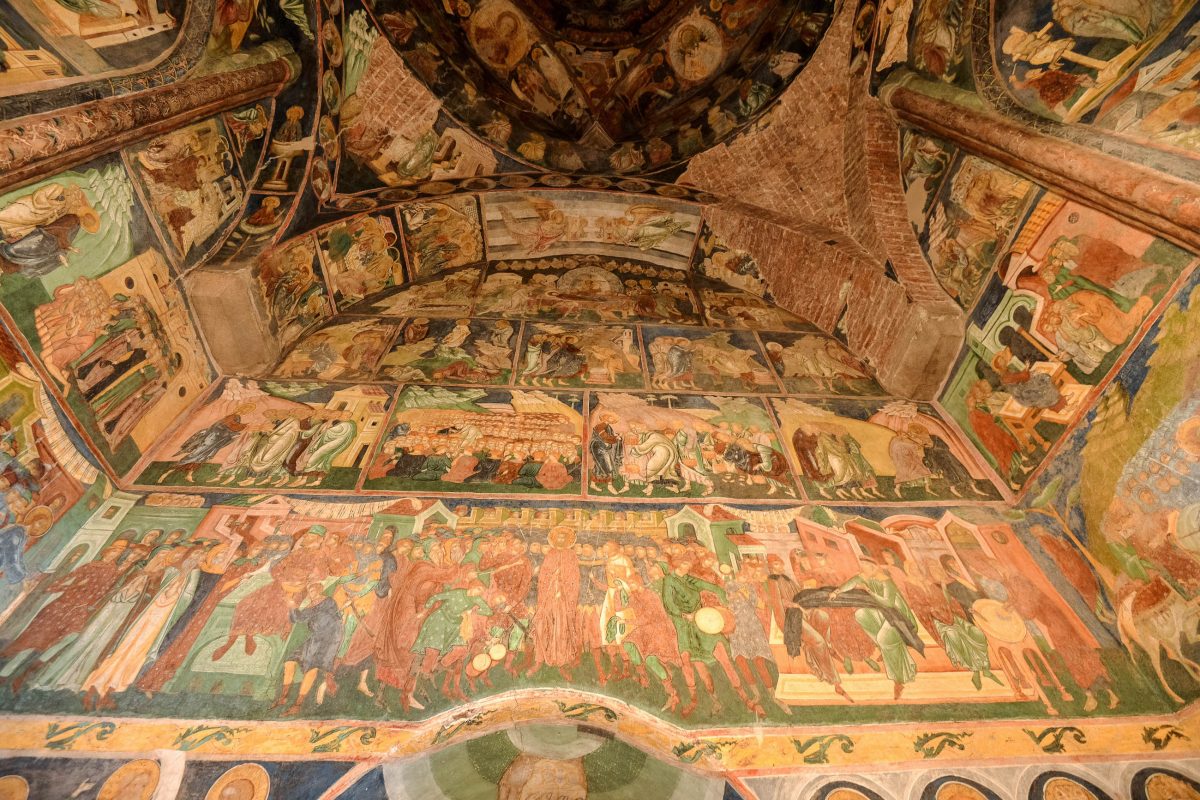
Die meisterhaften Malereien an der Kirche von Arbore stammen vom berühmten Meister Dragoș Coman aus Iași und dessen Schülern. Die überwiegende Farbe der Fresken ist Grün, wie an der Süd- und Westfassade noch gut zu erkennen ist. Hier sind die am besten erhaltenen Malereien zu finden, die um das Jahr 1541 entstanden sind.
Besonderer Betrachtung lohnt sich die Westfassade mit ihrer fast 2m tiefen Nische. Hier ist neben dem Leben von Heiligen die Schöpfung der Welt dargestellt. Die Südfassade zeigt die Geschichte von Moses, Adam und Eva im üppigen Garten Eden und das Jüngste Gericht.
Auch die Belagerung Konstantinopels, das berühmte „Aushänge-Fresko“ von Moldovița, ist hier zu finden. Über dem Eingangstor ist der Namenspatron der Kirche zu sehen: Johannes der Täufer mit seinem Kopf in einer Schale.
Pikantes Detail am Rande: Auch Luca Arbore fand 1523 seinen Tod durch Enthauptung nachdem er von Ștefăniță Vodă cel Tânăr, dem Enkel Stefans des Großen, wegen Hochverrats verurteilt wurde.
Einzigartige Arbore-Fresken – Lebendigkeit und Internationalität
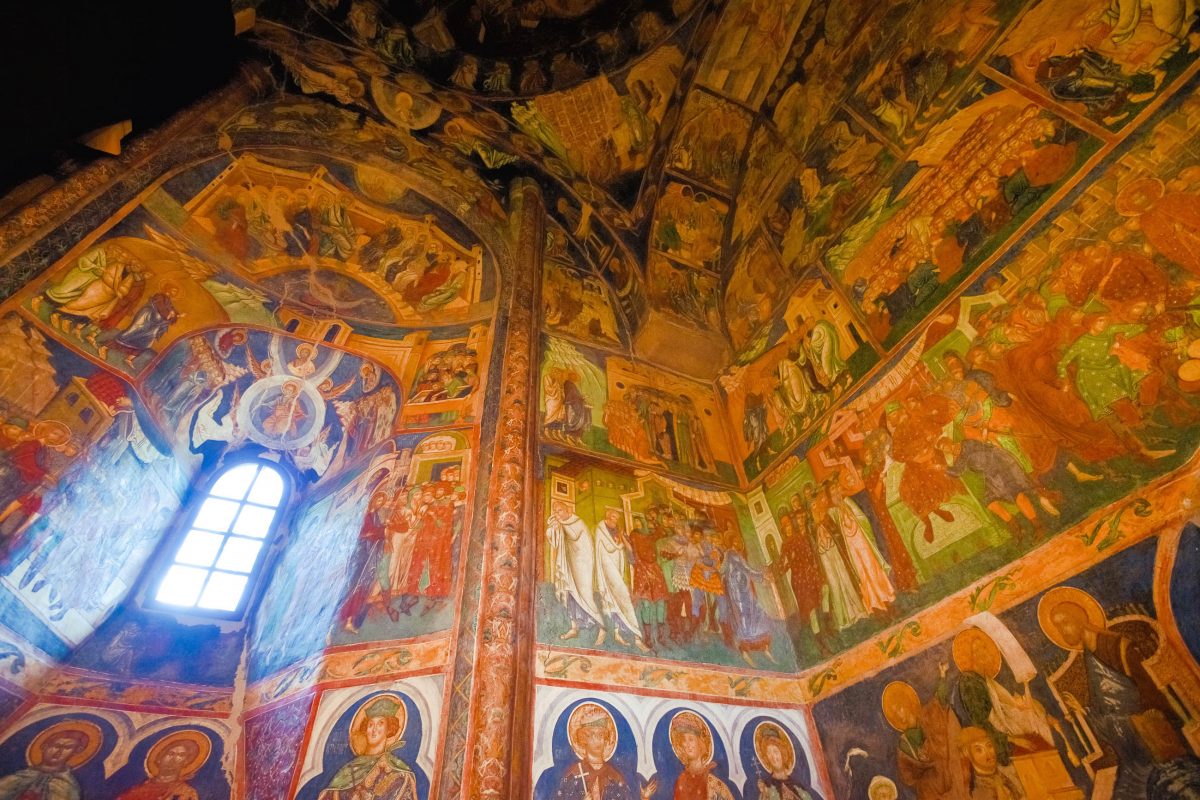
Die Fresken unterscheiden sich durch ihren hohen Detailgrad von den Malereien anderer Kirchenfassaden und wirken regelrecht lebendig. Erreicht wird dies durch die Verwendung von fünf unterschiedlichen Schattierungen aus insgesamt 47 Farbtönen.
Die gemeißelten Steintröge, in denen die Farben aus den Grundstoffen Gelb, Blau, Pink und Ocker gemischt wurden, sind in der Kirche heute noch zu sehen. Manche Figuren zeigen dem Betrachter den Rücken, eine untypische Szenerie, die den Bildern jedoch Leben und Bewegung verleiht.
Auch der Innenraum ist zur Gänze mit farbenprächtigen Motiven übersät, bei denen einige Besonderheiten auffallen. Manche Figuren tragen elegante Hüte, wie sie in der Region zur damaligen Zeit nicht bekannt waren und fallen durch ihre detaillierten Gesichtszüge auf. Dies lässt darauf schließen, dass der Malermeister viel herumgekommen ist und sich zum Beispiel von der Mode und der Malerei Italiens inspirieren ließ.

